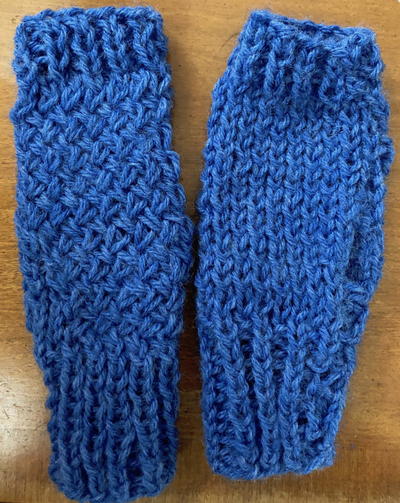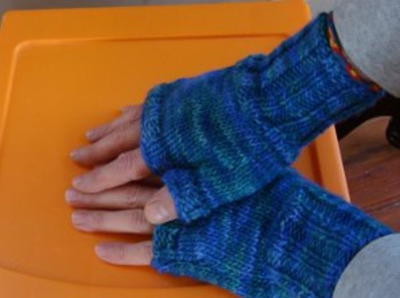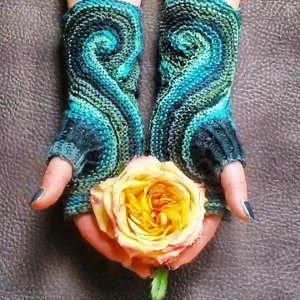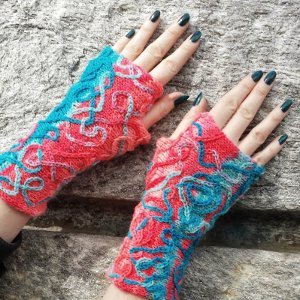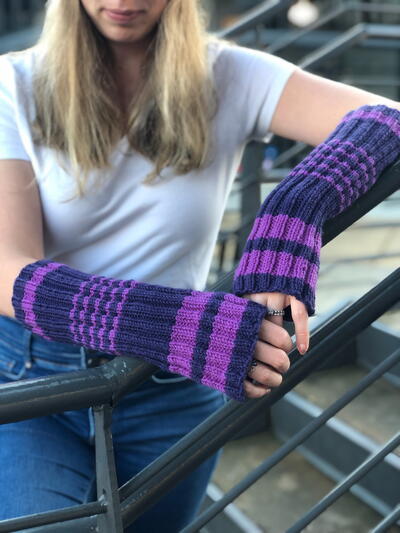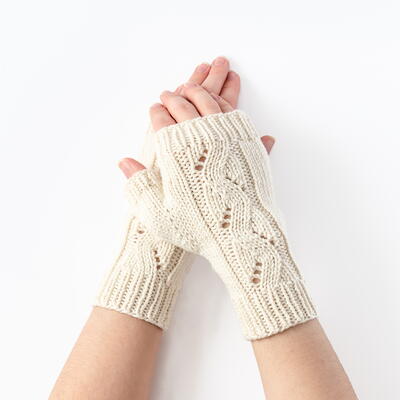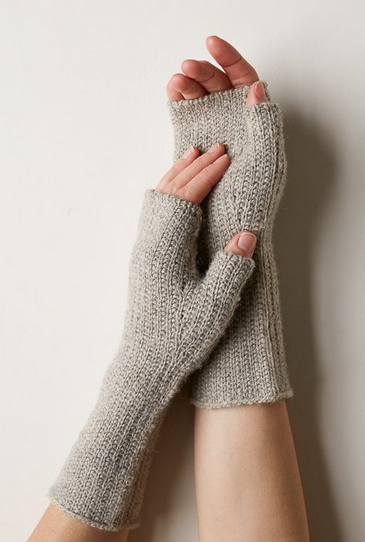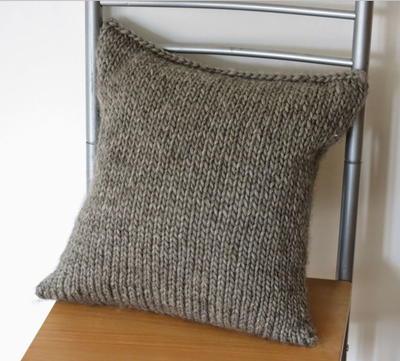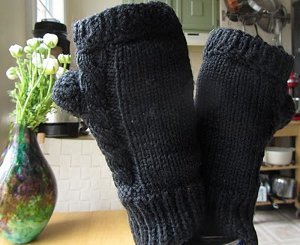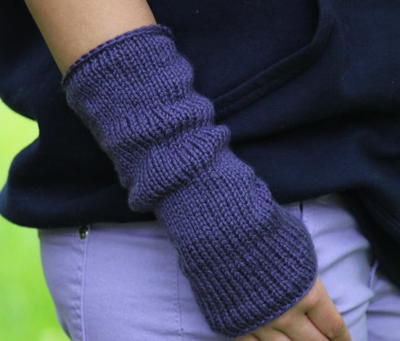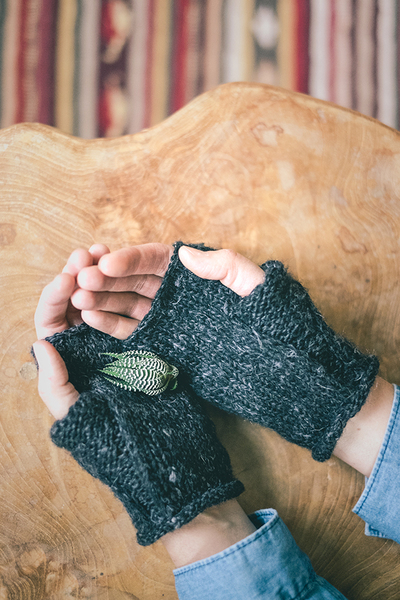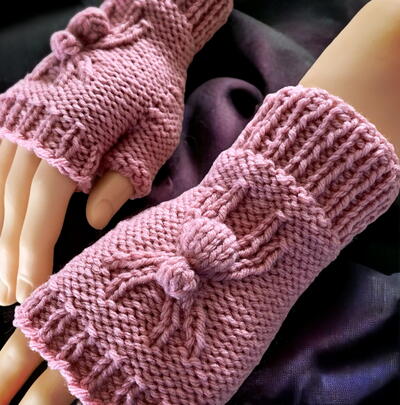This project was submitted by one of our readers, just like you.
Twisted Wristers
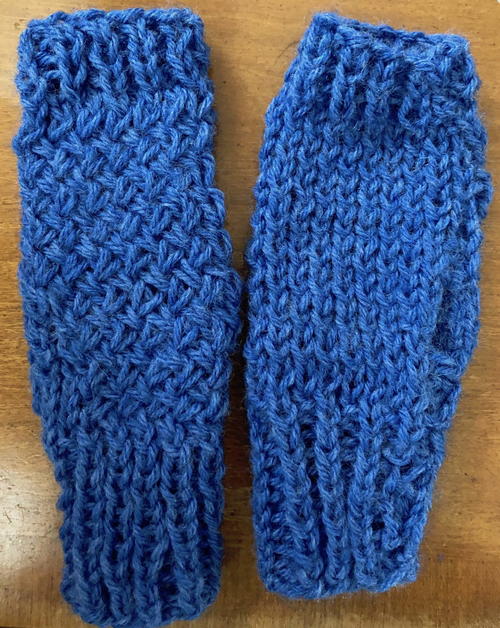
"This pattern is sized for a small adult woman hand. (I was able to get it onto my average woman size hand for the photo—but it it stretched). These have stockinette palms and a cross stitch for the back. (I’m sure this 1x1 cable stitch has a name, but I’ve never been able to find it). This uses worsted weight yarn (single color) with smaller than usual needles. I used 3.5mm. Note that I tend to knit loosely, so you might not want to go that small."
NotesPlease note that I knit left-handed. So if you knit right handed, you will have the mirror image of my work.

Knitting Needle Size4 or 3.5 mm
Yarn Weight(4) Medium Weight/Worsted Weight and Aran (16-20 stitches to 4 inches)
Materials List
- 3.5 mm needles (or size for your tension of knitting)
- worsted weight yarn (uses less than a skein)
- optional darning needle or crochet hook
Instructions
This pattern is sized for a small adult woman hand. (I was able to get it onto my average woman size hand for the photo—but it it stretched). These have stockinette palms and a cross stitch for the back. (I’m sure this stitch has a name, but I’ve never been able to find it). needle size: 3.5 mm yarn: worsted weight Terms: kfb: knit into front and back fo stitch (makes one additional stitch) p double: this means make a stitch by looping the yarn around the needle twice before purling so you have two loops in one stitch (these will become two separate stitches when you knit the next row). kcr2: this is really a 1x1 cable stitch. You don’t need a cable needle. Just knit into the back of the second stitch on the needle and then into the back of the first stitch and slide them both off. pcr2: this is really a 1x1 purled cable stitch. Purl the second stitch, then purl the first stitch and slide them both off. (This pattern offsets kcr2 and pcr2 so that the stitches appear to go on a diagonal. See photo). kcr2m: For row 16 on the first side, you want the second stitch on your working needle to end up having two loops in it (making a stitch). Because you are also cabling, you will knit the very first stitch, then skip the next one and knit to the back—but knit two loops into this stitch and then knit into the back of the one you skipped and slide them both off. Now, instead of having 3 stitches on the needle, you will have four. For row 16 on the second wrister, you are going in the other direction so you want that added stitch at the other end. When you get to the last three stitches, skip a stitch and knit into the back of the next stitch. Then knit a double loop into the back of the one you skipped. Slide both off and then knit the last stitch. You will now have a double loop in the second to let stitch on your needle. This will become two stitches when you go back the other way for row 17. NOTE: if making a stitch while doing the cable cross stitch does not work for you, you can simply pick up yarn from the previous row and knit into that (or your favorite way to make a stitch). k2tog: knit two together (decreases by one stitch) p2tog: purl two together (decreases by one stitch) right hand (if you knit left-handed. Otherwise, this is for left hand) cast on 20 (even numbered rows—all k k to front; odd numbered k to back) k1p1 for 3 more rows (total of 5 rows) row 6 k1p1 to2 from end. kfb, p1 (21 st) row 7 k1p1 row 8 k1p1 row 9 k1p1 row 10 k1p1 to 2 fro end. purl and knit to back into same stitch. purl last stitch (22 st) row 11 k1p1 row 12 knit across row 13 k1, *p10; p2 p double, p2 p double p2 p double p2 (25 st —11 for palm, 14 for back) row 14 k1 kcr2 kcr2 kcr2 kcr2 kcr2 kcr2 k1; k10 p1 row 15 k1 p10; pcr2 6 times, p1 p1 row 16: k1 kcr2m, kcr2 kcr2 kcr2 kcr2 kcr2 k1; k9, kfb, p1 (26 st) row 17: k1, p10; pcr2 7 times, p1 row 18 k2, kcr2 7 times; k9 p1 row 19 k1 p9, p1 pcr2 7 times, k1 row 20-30: odds same as row 19, evens same as row 20. row 31: k1 p9 *p2tog p2* to end (21 st) row 32: *k1p1* last 2: k2tog (20 st) row 33: k1p1 row 34 k1p1 cast off sew from top and bottom leaving room for thumb (knit or crochet around thumb hole if desired) left hand (if you knit left handed. Otherwise this is for right hand). I reversed the pattern from the right side (so the stockinette stitch is for the palm). Hopefully, I converted it properly. cast on 20 row 1: p1k1 row 2: p1k1 repeat 5 rows row 6: p1 kfb p1k1 (21 st) row 7: *p1k1* k last stitch row 8 p1k1 row 9 p1k1 row 10: p1 kfb *k1p1* k1 (22 st) row 11 p1k1 row 12 p1 knit across row 13: p2 p double, p2 p double, p2 p double, p2; p10, k1 (25 st) row 14: P1, K10; k1, kcr2 6 times, k1 row 15: p1, p1, pcr2 6 times; p10, k1 row 16: P1, kfb, K9; k1, kcr2 5 times, kcr2m k1 (26 st) Row 17: p1, pcr2 7 times; p10, k1 row 18: p1 k9; kcr2 7 times, p9 k1 rows 19-30: repeat rows 17 and 18 row 31: *p2 p2tog* 5 times (til 10 stitches remaining) p9, k1 (21 st) row 32: k2tog, *p1k1* (starts 1x1 rib for edge) (20 st) row 33: *p1k1* row 34: *p1k1* cast off in pattern. sew from top and bottom leaving room for thumb (knit or crochet around thumb hole if desired). Weave in yarn ends. Turn right side out. No blocking needed. Enjoy.


